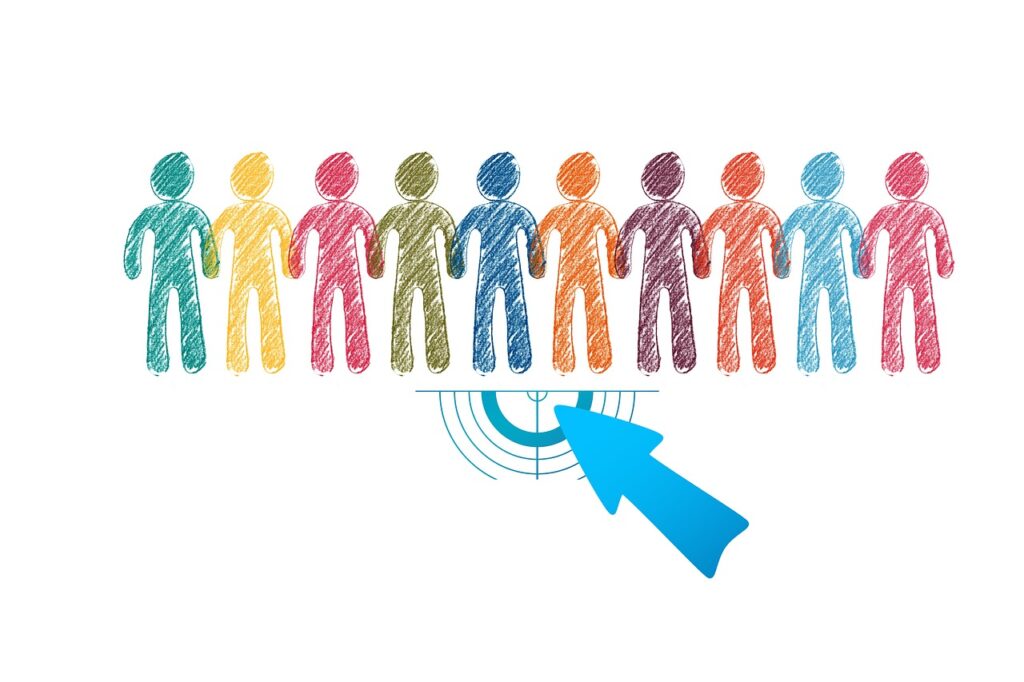A large percentage of the global population uses the Internet daily. Activities like shopping, research, social media interaction, and entertainment can be done online. Depending on how consumers interact with the internet, targeted advertising can be used to send out promotional messages.
Before the Internet, it was difficult to reach your desired audience using ads. Back in the day, ads were displayed on billboards, radio stations or even TV stations. Anyone could see these ads even though they did not need them.
Advertisers use targeted advertising to reach a specific group of people with similar traits, behaviours, interests and shopping habits. They are ads shown only to people who will find it helpful. Customers are segmented into groups using data gotten from their online activities and profiles.
It is a lot better to place targeted ads for customers, rather than customers seeing random ads that they do not find useful. Advertisers and customers both benefit from it because money is not wasted when running ads and customers only get to see things that interest them.
People are looking for personalized messages, products or services that are relevant to their wants and needs. When customers see ads relevant to them, they become interested in what you have to offer.
Targeted advertising is more likely to increase leads and conversions. This is why it is more effective in recent times.
Table of Contents
ToggleHow To Effectively Carry Out Targeted Advertising
This guide provides key steps and considerations for implementing targeted advertising successfully.
#1. Define Your Target Audience
Begin by clearly defining your target audience based on demographics, interests, behaviours, or other relevant criteria. Conduct thorough research to understand their characteristics, preferences, and motivations. This will help you tailor your messages and choose the most appropriate targeted advertising options.
#2. Gather and Analyze Data
Collect and analyze data related to your target audience. Leverage customer relationship management (CRM) systems, website analytics, social media insights, and other data sources to gain valuable insights about your audience’s online behaviour, purchase history, and preferences. This data will inform your targeting strategies and message customization.

#3. Select Targeting Options
Choose the most relevant targeting options based on your audience research and data analysis. This may include demographics, geographic location, interests, behaviours, or even device targeting. Consider the platforms and channels where your target audience is most active to ensure your targeted ads are displayed in the right context.
#4. Craft Customized Messages
Tailor your advertising messages to resonate with your target audience. Use the insights gained from audience research and data analysis to create compelling and relevant content. Personalize your targeted ads to address the specific needs, pain points, and aspirations of your audience. Customization can include language, imagery, offers, or calls to action that aligns with their preferences and interests.
#5. Continuously Optimize Campaigns
Monitor and track the performance of your targeted advertising campaigns. Analyze key metrics such as click-through rates, conversion rates, and return on ad spend (ROAS).
Use this data to identify areas of improvement and optimize your campaigns accordingly. Experiment with different messaging, visuals, targeting options, and platforms to find the most effective combination for your target audience.
#6. Test and Iterate
Implement A/B testing to experiment with different variations of your ads. Test different headlines, images, ad formats, and calls to action to determine what resonates best with your audience. Iterate based on the results of these tests, refining your messaging and targeting strategies to continuously improve campaign performance.
#7. Adhere to Privacy Regulations
Ensure compliance with privacy regulations, such as the General Data Protection Regulation (GDPR) or the California Consumer Privacy Act (CCPA). Respect user preferences regarding data collection and targeting. Provide transparent information about your data practices and offer opt-out options when necessary.

#8. Monitor and Adapt to Changes
Stay informed about changes in the advertising landscape, including updates to algorithms, privacy policies, and industry trends. Continuously adapt your targeting strategies and tactics to remain effective and compliant in the evolving targeted advertising ecosystem.
Benefits of Targeted Advertising
#1. Cost efficient
Cost efficiency is a key benefit of targeted advertising. By reaching a specific audience segment, advertisers can reduce wasted impressions and allocate their budget more effectively.
Targeted advertising allows them to avoid showing ads to individuals who are unlikely to be interested in their offerings, ensuring that every impression counts. This precise targeting maximizes the impact of the advertising budget by focusing on individuals who have a higher likelihood of responding positively.
As a result, advertisers can optimize their ad spend and achieve better results with lower costs. By reaching the right people at the right time, targeted advertising helps businesses make the most of their resources and improve the overall cost efficiency of their advertising campaigns.
#2. Customer satisfaction
Customer satisfaction is a valuable benefit of targeted advertising. This approach enables businesses to reach customers with content that aligns closely with their interests, needs, and preferences.
When customers encounter ads that are relevant to them, they are more likely to have a positive experience and feel understood by the brand.
This sense of personalization can lead to increased engagement, as customers are more inclined to pay attention to and interact with targeted ads.
By delivering meaningful and personalized experiences, targeted advertising fosters customer satisfaction, strengthens brand-customer relationships, and enhances the overall customer experience.
Satisfied customers are more likely to convert into loyal advocates, leading to improved customer retention and long-term business success.
#3. Increased sales and leads
Increased sales and leads are significant benefits of targeted advertising. By focusing on specific audience segments that are more likely to be interested in the promoted products or services, targeted advertising enhances the effectiveness of marketing campaigns.
When the right message reaches the right people at the right time, increasing the likelihood of generating sales and leads. By tailoring advertisements to the preferences, needs, and behaviours of the target audience, businesses can create a stronger impact and compel potential customers to take action.
Targeted advertising enables businesses to deliver compelling offers, personalized recommendations, and relevant content, which in turn can drive higher conversion rates and generate more qualified leads.
The result is an improvement in overall sales performance and a higher return on investment (ROI) for advertising efforts.
#4. Increased brand awareness and perception
Increased brand awareness and perception are benefits of targeted advertising. By delivering tailored messages to specific audience segments, targeted advertising helps businesses to effectively communicate their brand identity, values, and unique selling propositions.
Targeted ads ensure that the brand’s message reaches individuals who are more likely to be interested and receptive to it. By consistently reaching the right audience with relevant content, targeted advertising builds familiarity and recognition, leading to increased brand awareness.
Moreover, by aligning the messaging with the specific interests and preferences of the target audience, targeted advertising enhances brand perception and positioning.
It allows businesses to create a positive and personalized brand experience, improving the audience’s perception of the brand’s relevance and value. This, in turn, strengthens the brand’s reputation, credibility, and competitive edge in the market.

#5. Higher level of personalization
By leveraging data and insights about the target audience, targeted advertising allows businesses to deliver customized and tailored messages to individual consumers.
This personalized approach creates a more relevant and engaging advertising experience for customers. By addressing their specific needs, preferences, and interests, targeted advertising enhances the overall customer journey and strengthens the brand-consumer relationship.
Personalized ads can provide relevant product recommendations, exclusive offers, and content that resonates with each individual. This level of personalization fosters a sense of connection and understanding, making customers feel valued and appreciated by the brand.
As a result, customers are more likely to respond positively, engage with the advertising, and ultimately convert into loyal customers. The higher level of personalization achieved through targeted advertising enhances customer satisfaction, improves conversion rates, and drives long-term customer loyalty.
Types of targeted advertising
There are different ways to segment the audience to deliver the right targeted ads.
#1. Demographics targeting
Demographics targeting is a type of targeted advertising that focuses on reaching specific audience segments based on demographic characteristics such as age, gender, location, income level, and occupation.
By analyzing demographic data, businesses can tailor their advertising messages to appeal to the interests, needs, and behaviours of specific demographic groups.
Demographic targeting allows advertisers to customize their campaigns to match the preferences and characteristics of their target audience, ensuring that their ads are more relevant and compelling.
For example, an apparel retailer may target young adults aged 18-25 with trendy clothing options, while a luxury car brand may focus on high-income individuals in affluent areas.
By honing in on specific demographics, businesses can maximize the effectiveness of their advertising efforts, increase engagement, and ultimately achieve higher conversion rates and sales.
#2. Geographic targeting
Geographic targeting is another type of targeted advertising that allows businesses to reach specific audience segments based on their geographic location.
By tailoring ad campaigns to target customers in particular cities, regions, or countries, businesses can ensure that their messages are relevant and resonate with the local audience.
Geographic targeting enables businesses to customize their advertising content to suit the preferences, needs, and cultural nuances of specific locations.
For example, a local boutique can use geographic targeting to promote in-store events or discounts to residents in the surrounding area. By reaching the right audience in the right location, businesses can increase their chances of driving foot traffic, generating leads, and converting customers.
Geographic targeting helps businesses optimize their advertising spend by focusing on specific geographical areas where their target market resides, ensuring that their ads have a higher impact and relevance to the local population.
#3. Interests and behaviour
Interests and behavior targeting focus on reaching specific audience segments based on their preferences, online behaviour, and interests.
By analyzing user data and tracking online activities, businesses can create personalized ad campaigns that align with the interests and behaviours of their target audience.
This type of targeting allows advertisers to deliver relevant and tailored messages to individuals who have demonstrated specific interests or behaviours, such as visiting certain websites, engaging with specific content, or participating in particular online communities.
For example, an outdoor gear retailer can target ads to individuals who have shown an interest in hiking or camping.
By aligning ads with the interests and behaviours of the target audience, businesses can increase engagement, drive conversions, and establish a stronger connection with their customers. Interests and behaviour targeting enable businesses to deliver more relevant and appealing ads, leading to improved campaign performance and overall marketing effectiveness.
#4. Contextual targeting
Contextual targeting focuses on delivering ads to users based on the context of the content they are currently engaging with.
This approach involves analyzing the web page’s content, keywords, and topics to determine its relevance to the advertiser’s product or service. Ads are then displayed to users who are consuming content related to the targeted keywords or topics.
For example, an electronics company may display their ads on websites or articles about technology and gadgets. Contextual targeting allows advertisers to reach audiences who are actively interested in specific subjects, ensuring that ads are displayed in a relevant and timely manner.
By aligning ads with the context of the content being viewed, businesses can increase the chances of capturing the attention of users and driving engagement. Contextual targeting enables advertisers to effectively target their desired audience based on their immediate interests and needs, improving the overall effectiveness of their advertising campaigns.
#5. Device targeting
Device targeting is a type of targeted advertising that focuses on reaching specific audience segments based on the devices they use, such as smartphones, tablets, or desktop computers.
By analyzing device-related data, businesses can tailor their ad campaigns to deliver optimized experiences for different devices. For example, a mobile gaming app may target ads specifically to smartphone users to promote in-app purchases or new game releases.
Device targeting enables advertisers to optimize their ads based on the capabilities and characteristics of different devices, ensuring that the content is displayed appropriately and in a user-friendly manner.
This approach allows businesses to create personalized ad experiences that are tailored to the specific features and behaviours associated with each device, leading to improved engagement and higher conversion rates.
Device targeting helps businesses maximize the impact of their advertising efforts by delivering ads that are optimized for the devices that their target audience uses most frequently.
Conclusion
Targeted advertising is beneficial to both advertisers and consumers. Advertisers get the best out of their ads when they are tailored to a specific group of people. This way they get the desired results, and avoid waste of essential resources used to run the ads.
Consumers also prefer when they see ads that interest them and are beneficial to them. This way their needs and wants are catered for through online targeted advertising.









